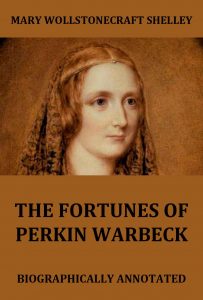The Fortunes Of Perkin Warbeck – Mary Wollstonecraft Shelley
In this novel, Mrs. Shelley sets out with the somewhat startling statement of her firm belief that Perkin Warbeck was in reality the lost Duke of York. She is of opinion, that it is impossible for anyone to examine the records in the Tower without arriving at the same conclusion; and sometimes even in the course of the story, we think she overlooks the resemblance of the romance in her eagerness to impress upon the reader her own peculiar view of the historical fact. The various adventures of the unfortunate Perkin, (or the young Prince, as she will have it,) from his escape out of the Tower in childhood to the termination of his career upon the scaffold, form the subject-matter of the work.
The characters are skillfully portrayed, and well contrasted with each other, while the descriptions are full, clear, and powerful. Throughout, indeed, the book is written with great energy, both of thought and expression, as well as with all that feminine delicacy of feeling and perception which throws such a peculiar charm over the actions penned by an accomplished woman.
Format: Paperback.
The Fortunes Of Perkin Warbeck.
ISBN: 9783849694890
Available at amazon.com and other venues.
Biography of Mary Wollstonecraft Shelley (from Wikipedia):
Mary Wollstonecraft Shelley (née Godwin; 30 August 1797 – 1 February 1851) was an English novelist, short story writer, dramatist, essayist, biographer, and travel writer, best known for her Gothic novel Frankenstein: or, The Modern Prometheus (1818). She also edited and promoted the works of her husband, the Romantic poet and philosopher Percy Bysshe Shelley. Her father was the political philosopher William Godwin, and her mother was the philosopher and feminist Mary Wollstonecraft.
After Wollstonecraft’s death less than a month after her daughter Mary was born, Mary was raised by Godwin, who was able to provide his daughter with a rich, if informal, education, encouraging her to adhere to his own liberal political theories. When Mary was four, her father married a neighbour, with whom, as her stepmother, Mary came to have a troubled relationship.
In 1814, Mary began a romance with one of her father’s political followers, Percy Bysshe Shelley, whom she eventually married. Together with Mary’s stepsister Claire Clairmont, Mary and Shelley left for France and travelled through Europe. Upon their return to England, Mary was pregnant with Percy’s child. Over the next two years, she and Percy faced ostracism, constant debt, and the death of their prematurely born daughter. They married in late 1816, after the suicide of Percy Shelley’s first wife, Harriet.
In 1816, the couple famously spent a summer with Lord Byron, John William Polidori, and Claire Clairmont near Geneva, Switzerland, where Mary conceived the idea for her novel Frankenstein. The Shelleys left Britain in 1818 for Italy, where their second and third children died before Mary Shelley gave birth to her last and only surviving child, Percy Florence Shelley. In 1822, her husband drowned when his sailing boat sank during a storm near Viareggio. A year later, Mary Shelley returned to England and from then on devoted herself to the upbringing of her son and a career as a professional author. The last decade of her life was dogged by illness, probably caused by the brain tumour that was to kill her at the age of 53.
Until the 1970s, Mary Shelley was known mainly for her efforts to publish her husband’s works and for her novel Frankenstein, which remains widely read and has inspired many theatrical and film adaptations. Recent scholarship has yielded a more comprehensive view of Mary Shelley’s achievements. Scholars have shown increasing interest in her literary output, particularly in her novels, which include the historical novels Valperga (1823) and Perkin Warbeck (1830), the apocalyptic novel The Last Man (1826), and her final two novels, Lodore (1835) and Falkner (1837). Studies of her lesser-known works, such as the travel book Rambles in Germany and Italy (1844) and the biographical articles for Dionysius Lardner’s Cabinet Cyclopaedia (1829–46), support the growing view that Mary Shelley remained a political radical throughout her life. Mary Shelley’s works often argue that cooperation and sympathy, particularly as practised by women in the family, were the ways to reform civil society. This view was a direct challenge to the individualistic Romantic ethos promoted by Percy Shelley and the Enlightenment political theories articulated by her father, William Godwin.
(The text of the last section was taken from a Wikipedia entry and is available under the Creative Commons Attribution-ShareAlike License.)
Publisher’s Note: This book is printed and distributed by Createspace a DBA of On-Demand Publishing LLC and is typically not available anywhere else than in stores owned and operated by Amazon or Createspace.

